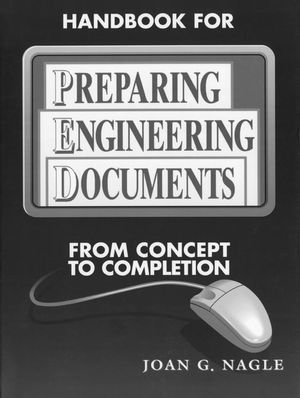Handbook for Preparing Engineering Documents: From Concept to CompletionISBN: 978-0-7803-1097-1
Paperback
392 pages
October 1995, Wiley-IEEE Press
 This is a Print-on-Demand title. It will be printed specifically to fill your order. Please allow an additional 15-20 days delivery time. The book is not returnable.
|
||||||
Tables.
Preface.
How to use this book.
Acknowledgments.
1 INTRODUCTION.
Why document our work?
Why do it well?
Preparing documents as an engineering process.
How this book is organized.
2 REQUIREMENTS ANALYSIS.
Purpose.
Audience.
Needs.
Content.
Economy.
Compatibility.
Approach.
Background.
Technical expertise.
Reading ability.
Cultural factors.
Attitude.
Time.
3 DESIGN.
Design methods.
Getting started.
Clustering.
Outlining.
Dividing up the work.
Design parameters.
Arrangement.
Elegance.
Appearance.
Summary of prestructuring work.
4 COMPONENTS AND ASSEMBLY.
Verbal components and assembly.
Components.
Words.
Phrases/clauses.
Sentences.
Paragraphs.
Headings, subheadings, and captions.
Assembly.
Grammar.
Syntax.
Punctuation.
Illustrative components.
Graphs.
Charts.
Line drawings.
Photographs.
Graphic elements.
Data components.
Equations.
Tables.
Computer printouts.
Expression of numerical information.
Integration.
5 CONTROLS.
Engineering judgment.
Honesty.
Objectivity.
Credit.
Attitude.
Inclusiveness.
Collaborator/team control.
Company control.
Technical information.
Proprietary information.
Sensitive information.
Legal control.
Copyright law.
Obtaining a copyright.
Using copyrighted material.
Liability law.
6 PACKAGING.
Formatting.
Character format.
Typeface.
Type style.
Type size.
Paragraph format.
Line length.
Indentation.
Paragraph spacing.
Headings and paragraph identifiers.
Style sheets and specified formats.
Style sheets.
Customer-specified formats.
Standard Generalized Markup Language.
Hypertext Markup Language.
Illustration format.
Table format.
Type style and size.
Alignment.
Borders, blocks, and leaders.
Captions.
Footnotes.
Continuation pages.
Page setup.
Margins.
Paper size.
Orientation.
Page makeup.
Document consolidation.
Pagination.
Footnotes/references.
Front/back matter.
Paper.
Binding.
Wire stitching.
Mechanical binding.
Perfect binding.
Other binding considerations.
Tabs and breaker pages.
Inserts and enclosures.
Folding.
Jogging and trimming.
7 TESTING.
Functionality testing.
Usability testing.
User reviews.
User interviews.
Usability tests.
Quality assurance.
Editing.
Electronic editing.
Format editing.
Illustration editing.
Data editing.
Critical reading.
Proofreading.
8 PRODUCT ION.
Production management.
Protection.
Protection against loss.
Protection from unauthorized access.
Consensus/clearance.
Iteration control.
Large document management.
Scheduling.
Parallel development.
Formal planning.
Problem-solving.
Contingency.
Prototype production.
Methods.
Text.
Illustrations.
Data.
Advanced publishing technologies and services.
Prepress work.
Pilot-scale production.
Full production.
Printing methods.
Printing costs.
Distribution.
Distribution lists.
Distribution methods.
Distribution control and change management.
Electronic production/distribution.
Deciding to go electronic.
Creating online documentation.
9 BIBLIOGRAPHY.
References.
Resources.
Requirements analysis, design, components and assembly.
Controls.
Packaging.
Testing.
Production.
Mechanics of documentation.
Dictionaries.
APPENDIX: MECHANICS OF DOCUMENTATION.
QUICK-REFERENCE GUIDES.
Abbreviations and acronyms.
Capitalization.
Compounding.
Metric conversions.
Numbers.
Punctuation.
References and notes.
Spelling.
Symbols.
Usage.
Index.



